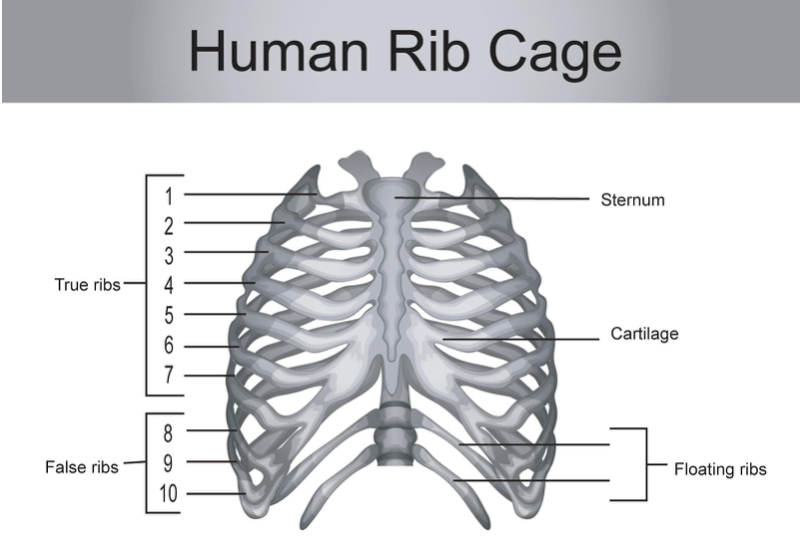
The number of pairs of true ribs is
(a) 6
(b) 7
(c) 9
(d) 10
Answer
499.2k+ views
1 likes
Hint: The number of pairs of true ribs is a prime number. The number count is the same as the number that corresponds to the wonders of the world and the colors present in the rainbow. It corresponds to the atomic number of nitrogen.
Complete answer:
There are 12 pairs of ribs, sternum, cartilage, and thoracic vertebrae in our thoracic cage or rib cage. The first 7 pairs (1-7) of the 12 pairs of ribs are attached posteriorly to the vertebrae and anteriorly to the sternum (with costal cartilage). These pairs of ribs are called true (or sternal) ribs.

Costal cartilages connect the first seven pairs directly to the sternum and are referred to as true ribs. False ribs that do not actually join the sternum but are bound by cartilage to the 7th rib are called the 8th, 9th, and 10th pairs. Via the costal cartilage of the ribs above them, the 8-10 rib pairs attach indirectly to the sternum. The 11 and 12 pairs of ribs do not at all attach to the sternum. Therefore, the floating ribs are called the 11th and 12th pairs.
The first rib is distinctive and simpler than other ribs to discern. It is a C-shaped, short, and flat bone. The vertebral attachment to the first thoracic vertebra can be located just below the spine, and the remainder of this bone can be located above the clavicle mark. Ribs 2 through 7 have a more conventional look and, as they move downwards, become longer and less curved.
So, the correct answer is, ‘7’.
Note: In the vertebrate anatomy, the long curved bones which form the rib cage, part of the axial skeleton, are ribs. In order to help protect internal organs, human ribs are flat bones that form part of the rib cage. Usually, humans have 24 ribs in 12 pairs. There is an extra rib known as a Cervical rib in 1 in 500 individuals. The head, collar, body (or shaft), tuberculum, and angle are the parts of a rib.
Complete answer:
There are 12 pairs of ribs, sternum, cartilage, and thoracic vertebrae in our thoracic cage or rib cage. The first 7 pairs (1-7) of the 12 pairs of ribs are attached posteriorly to the vertebrae and anteriorly to the sternum (with costal cartilage). These pairs of ribs are called true (or sternal) ribs.

Costal cartilages connect the first seven pairs directly to the sternum and are referred to as true ribs. False ribs that do not actually join the sternum but are bound by cartilage to the 7th rib are called the 8th, 9th, and 10th pairs. Via the costal cartilage of the ribs above them, the 8-10 rib pairs attach indirectly to the sternum. The 11 and 12 pairs of ribs do not at all attach to the sternum. Therefore, the floating ribs are called the 11th and 12th pairs.
The first rib is distinctive and simpler than other ribs to discern. It is a C-shaped, short, and flat bone. The vertebral attachment to the first thoracic vertebra can be located just below the spine, and the remainder of this bone can be located above the clavicle mark. Ribs 2 through 7 have a more conventional look and, as they move downwards, become longer and less curved.
So, the correct answer is, ‘7’.
Note: In the vertebrate anatomy, the long curved bones which form the rib cage, part of the axial skeleton, are ribs. In order to help protect internal organs, human ribs are flat bones that form part of the rib cage. Usually, humans have 24 ribs in 12 pairs. There is an extra rib known as a Cervical rib in 1 in 500 individuals. The head, collar, body (or shaft), tuberculum, and angle are the parts of a rib.
Latest Vedantu courses for you
Grade 9 | CBSE | SCHOOL | English
Vedantu 9 CBSE Pro Course - (2025-26)
School Full course for CBSE students
₹37,300 per year
Recently Updated Pages
Master Class 11 Business Studies: Engaging Questions & Answers for Success

Master Class 11 Economics: Engaging Questions & Answers for Success

Master Class 11 Accountancy: Engaging Questions & Answers for Success

Master Class 11 Computer Science: Engaging Questions & Answers for Success

Master Class 11 English: Engaging Questions & Answers for Success

Master Class 11 Maths: Engaging Questions & Answers for Success

Trending doubts
Which one is a true fish A Jellyfish B Starfish C Dogfish class 11 biology CBSE

Difference Between Prokaryotic Cells and Eukaryotic Cells

1 ton equals to A 100 kg B 1000 kg C 10 kg D 10000 class 11 physics CBSE

1 Quintal is equal to a 110 kg b 10 kg c 100kg d 1000 class 11 physics CBSE

One Metric ton is equal to kg A 10000 B 1000 C 100 class 11 physics CBSE

How much is 23 kg in pounds class 11 chemistry CBSE




